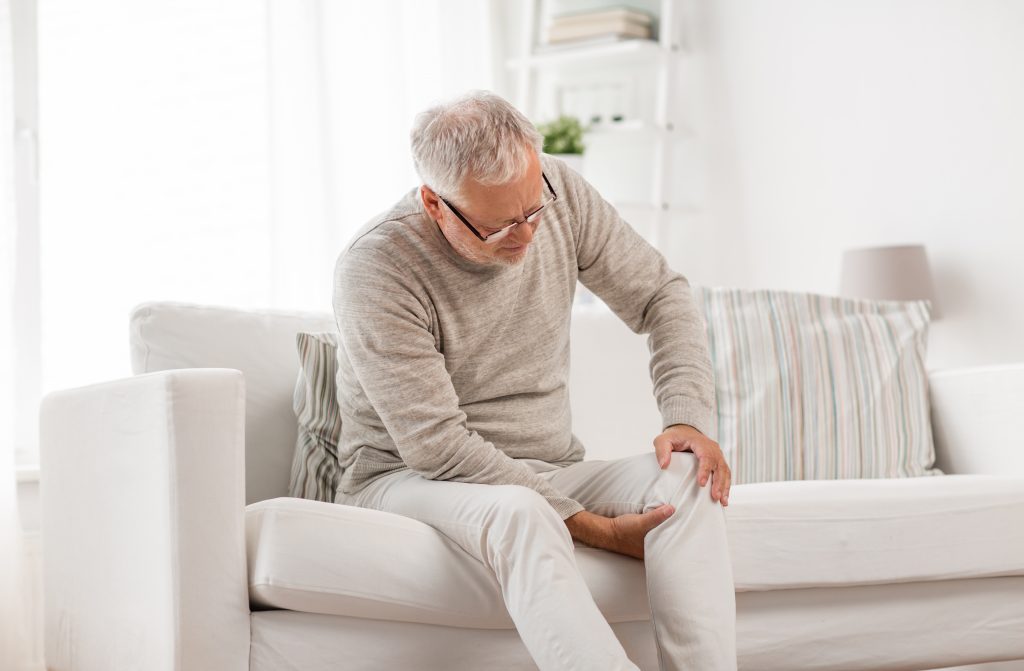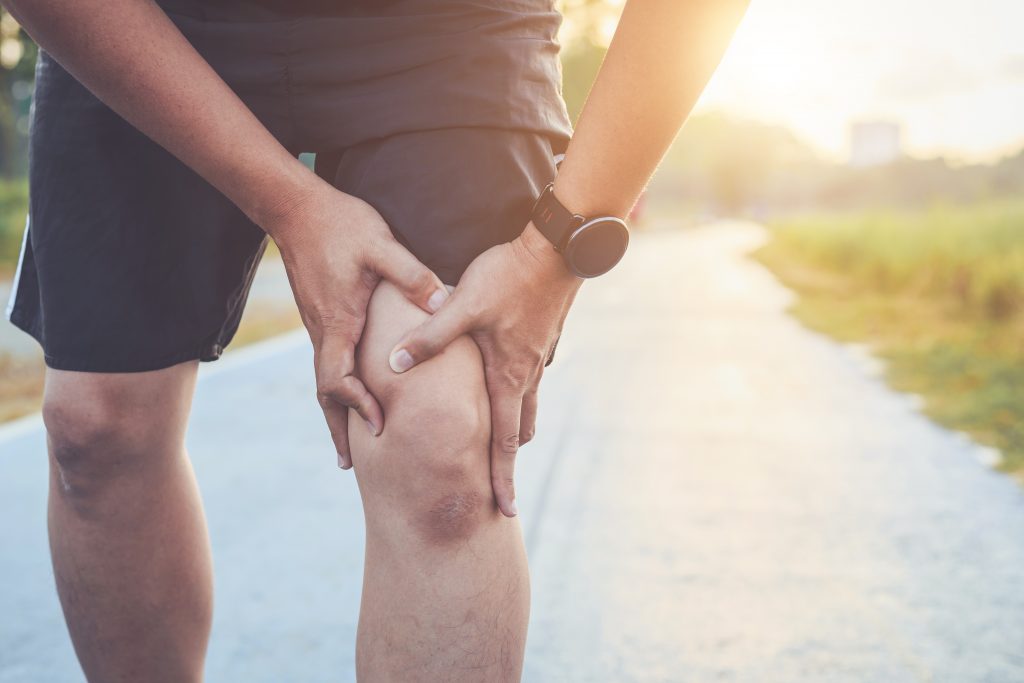March 11, 2022
7 Causes of Burning Knee Pain
Burning pain in the knee can be an incredibly unpleasant experience. It often feels like the joint is on fire or as if there’s something sharp sticking into the joint or poking it. When there’s a constant burning sensation in the knee, walking, relaxing, or even sleeping can be difficult. And, when we’re tired, pain seems to feel a whole lot worse.
Most of the time, burning in the knee indicates a serious issue with the knee joint itself. However, it can also reveal significant issues elsewhere in the body. Sometimes, it’s simply a matter of overuse requiring a fair amount of rest.
In this article, we’re going to discuss the most common causes behind burning knees and when it’s time to seek medical attention.
The Location of Your Burning Knee Pain
It’s safe to say that your knees take on a lot of strain each day, and not all strain is created equal. Therefore, the location of your burning knee pain can serve as a clue to the cause.
Let’s talk about location-specific knee pain and burning:
 The Front of Your Knee
The Front of Your Knee
When you have consistent burning pain in the front of your knee, it could be due to excessive stress on the patella tendon, often caused by overuse. However, the cause could be much more severe, indicating a dislocated patella, a deteriorating or softening patella, or an accumulation of fluids and swelling.
The Back of Your Knee
If you feel a sharp stabbing pain behind your knee, the cause may be inflamed tendons resulting in hamstring tendonitis from overuse. Additionally, swelling and tightness could indicate a cyst that formed from a mechanical abnormality, producing excess fluids.
Lastly, pain in the back of your knee could be the consequence of a torn meniscus.
The Side or Outside of Your Knee
Burning knee pain that feels as if it’s on the outside of your entire knee or off to the side could be due to something called Iliotibial band syndrome, especially if the outside of the thigh area is inflamed and irritated.
A tear in one of the two menisci can also cause pain and swelling outside of the knee, but usually in a way that makes the knee feel as if it’s locking up or giving way. A burning sensation in the knee from the outside could also indicate pressure from a fluid-filled cyst.
The Inside of Your Knee
Burning pain on the inside of your knee usually refers to the tissue fold medically known as medial plica becoming irritated from overuse or apparent injury. This is very common and often goes undiagnosed as it can’t be seen on an MRI scan.
Why Is My Knee Burning? The 7 Common Causes of Burning Knee Pain
Location is only one factor involved in diagnosing burning knee pain. Now let’s talk about the most common causes behind the discomfort:
1. Trauma
When we talk about knee trauma, we’re talking about cartilage or ligament tears.
The knee cartilage or the meniscus gives the knee joints cushioning during physical activities. If an individual sustains an injury to this area or twists it forcefully, the cartilage can tear, causing a burning sensation in your entire knee.
In some instances, the cartilage can heal on its own with proper care. In more severe instances, steroid injections or surgery may be needed.
Ligament tears are often the result of blunt force trauma to the outside of the knee. Ligament tears can range from partial to severe, requiring muscle strengthening therapy or surgery.
2. Gout
Gout is an inflammatory condition caused by high levels of uric acid in the bloodstream. It’s a very common culprit behind burning knee pain and tends to happen rapidly over a few hours—usually at night.
When gout flares up, the entire joint becomes swollen and feels hot to the touch. As a result, it can become too painful to walk. These flare-ups usually settle within a few weeks but often return and require ongoing medical treatment.
3. Chondromalacia Aka, “Runner’s Knee”
Chondromalacia, or runner’s knee, occurs as a result of overuse of the knee joints. It’s very common among runners and individuals who consistently put physical stress and pressure on their knees.
It’s very common among runners and individuals who consistently put physical stress and pressure on their knees.
Ultimately, the cause of runner’s knee is from the cartilage deteriorating, leaving less cushioning for the joint during activities. This usually causes burning pain on the front of the knee, but it can feel like your entire knee is on fire.
An ice pack and rest can usually solve the problem. However, severe cases may require surgery to smooth the cartilage.
4. Osteoarthritis
Osteoarthritis affects the lives of 30.8 million people in the US. It can affect virtually any joint, but it’s mostly known to affect the hands, hips, spine, and knees.
Osteoarthritis is due to the wearing down of protective cartilage and is impossible to reverse. Treatment can vary from pain and inflammation management medications to cortisone injections and may eventually require a joint replacement surgery
5. Patellar Tendinitis
Patellar tendonitis is caused by overuse resulting in injury to the tendon that connects your knee cap to your shin. If you feel a burning pain in the front of your knee, patellar tendonitis is likely the reason.
Depending on the severity of the tendinitis, an individual may simply need rest or a more invasive therapy recommended by a doctor, such as platelet-rich plasma injections.
6. Knee Bursitis
There are small fluid-filled pockets between soft tissue and bone called the bursa. They reduce friction, allowing for the body’s smooth movements. There are 15 bursae located around each knee, and when any of them become inflamed, the result is burning knee pain.
This is also known as knee bursitis, and it usually has obvious swelling. Knee bursitis can occur in any part of the knee, and it can be caused by different things, such as overuse and injury. Bursitis usually requires a doctor to examine and assess for treatment.
7. Iliotibial Band Syndrome
 Iliotibial band syndrome (ITBS) most commonly affects runners. It occurs when the connective tissue that runs along the length of the thigh rubs against the outside of the knee during physical activities. Whenever this connective tissue, or band, rubs against the side of the knee, a burning sensation crops up.
Iliotibial band syndrome (ITBS) most commonly affects runners. It occurs when the connective tissue that runs along the length of the thigh rubs against the outside of the knee during physical activities. Whenever this connective tissue, or band, rubs against the side of the knee, a burning sensation crops up.
There’s no formal treatment for ITBS. Resting, getting massages, strengthening core muscles, applying ice, and taking over-the-counter pain relievers can help relieve discomfort. In more severe cases, local steroid injections are an option as recommended by a doctor.
When to Seek Medical Attention
For most burning knee pain issues, the best solution is to rest, apply an ice pack, and focus on strengthening the muscle around the knee. However, if you’re feeling a consistent burning sensation in your knee that continues to build despite taking it easy — especially if this burning knee pain keeps you from moving around — then it’s time to visit your doctor.
You should never take for granted what your knees do for you. If you’ve sustained a knee injury or have ongoing knee burning pain, schedule an appointment with us today.
DISCLAIMER
The information featured in this site is general in nature. The site provides health information designed to complement your personal health management. It does not provide medical advice or health services and is not meant to replace professional advice or imply coverage of specific clinical services or products. The inclusion of links to other web sites does not imply any endorsement of the material on such websites.